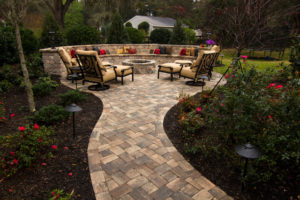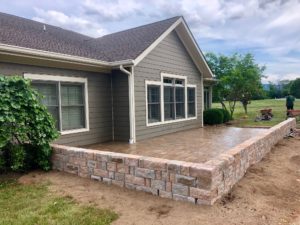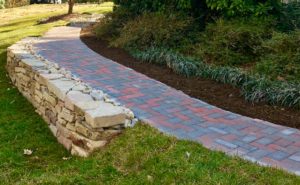Hardscaping by definition is built to last. Paver patio’s, walkways, segmental retaining walls, stairs, freestanding walls, and columns are beautiful durable additions to any property that can offer years of outdoor enjoyment. Over time however, the weather can have an impact on your outdoor feature and it can begin to deteriorate if proper, preventative maintenance is not preformed.
Proper maintenance does not have to be a herculean task. There are simple, regular chores to be preformed to ensure that it always looks its best.
This first chore may make you feel like a bit of a Disney Princess but sweep your hardscape regularly to keep it free from debris. Once you’re done spray the stone down with a garden hose to ensure the majority of the nitty gritty bits are washed away. This may not be practical in the winter months but it is a nice way to cool down in the summer. In fall, over the winter, and in to spring dirt & vegetation gets an opportunity to collect. This can stain your pavers, low blocks, & block lips on a segmental wall. If this occurs know that the majority of stains can be removed by water, detergent, and good old elbow grease. Mold, moss, & oil based stains often require a different approach.
A paver sealant is a good option for an area with high use, or for a property that only gets used on occasion. There are a variety of different sealer finishes. Sealed pavers are easier to clean. The sealer will diminish over time especially in higher use hardscapes and may need to be resealed a bit more often than one that is used only intermittently.
Getting down and dirty with your hardscape allows you the opportunity to really inspect it. You can inspect your hardscape for gaps in the joints, any cracked or chipped pavers. A polymeric joint sweep can be reapplied easily. Re-application after pressure washing is typically a given. Often times you should replace compromised pavers as cracks tend to increase & spread over seasons of freezing & thawing. Individual stones are easy to replace. Look for dips or low spots in your paver surface, or a sag/bulge in your wall while you’re at it. This can be an indication of a more serious structural problem that could need to be addressed sooner rather than later.
Water will begin to collect in new areas on a patio that is becoming uneven. Pooling water can damage a hardscape quickly so it is best to contact a professional hardscape company to come out an assess the situation.
With a wee bit of diligent maintenance and a watchful eye you can be confident that your hardscape investment will not only add value to the property but to your daily life overall.







